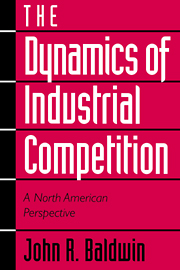Book contents
- Frontmatter
- Contents
- preface
- Acknowledgements
- 1 The dynamics of competition
- 2 Greenfield entry and closedown exit
- 3 Entry, exit, and the merger process
- 4 The rise and fall of incumbents
- 5 Patterns of large- and small-firm mobility
- 6 Plant turnover in Canada and the United States
- 7 Measures of market structure and the intensity of competition
- 8 The relationship between mobility and concentration
- 9 Turnover and productivity growth
- 10 Merger success
- 11 Turnover in domestic and foreign enterprises
- 12 Industry efficiency and firm turnover in the Canadian manufacturing sector
- 13 Firm turnover and profitability
- 14 Modelling entry
- 15 Conclusion
- Appendix A Measuring firm turnover – methodology
- Appendix B Definition of concentration and mobility measures
- Notes
- References
- Author index
- Subject index
5 - Patterns of large- and small-firm mobility
Published online by Cambridge University Press: 30 March 2010
- Frontmatter
- Contents
- preface
- Acknowledgements
- 1 The dynamics of competition
- 2 Greenfield entry and closedown exit
- 3 Entry, exit, and the merger process
- 4 The rise and fall of incumbents
- 5 Patterns of large- and small-firm mobility
- 6 Plant turnover in Canada and the United States
- 7 Measures of market structure and the intensity of competition
- 8 The relationship between mobility and concentration
- 9 Turnover and productivity growth
- 10 Merger success
- 11 Turnover in domestic and foreign enterprises
- 12 Industry efficiency and firm turnover in the Canadian manufacturing sector
- 13 Firm turnover and profitability
- 14 Modelling entry
- 15 Conclusion
- Appendix A Measuring firm turnover – methodology
- Appendix B Definition of concentration and mobility measures
- Notes
- References
- Author index
- Subject index
Summary
Even in the world of giant firms, new ones arise and others fall into the background. Innovations still emerge primarily with the “young” ones, and the “old” ones display as a rule symptoms of what is euphemistically called conservatism.
Joseph Schumpeter (1939: 71)Introduction
The preceding chapters outline the amount of turnover in the industrial population. They focus on a relatively aggregate level – presenting, for the most part, statistics that summarize the average levels of various components of firm turnover. These include greenfield entry and closedown exit, share change in continuing firms, and the frequency of mergers.
The amount of turnover depends on the amount of shifting that takes place in market shares and also on the pattern of these changes. It is possible that the turnover that occurs as one firm supplants another is completely random. This could occur if large and small firms had equal probabilities of growing or if the rates of growth did not depend on the size of the firm. On the other hand, there may be a pattern to the turnover in market share. Large firms may supplant small firms or small firms may grow at the expense of large firms.
The pattern of market-share change has important implications for competition policy. The reasons for this vary, depending on which conceptual framework is used.
One such framework is the stochastic-growth model associated with the work of Simon and Bonini (1958), Steindl (1965), and Prais (1976). This literature stresses the importance of determining the relationship between the amount of growth or decline and firm size.
- Type
- Chapter
- Information
- The Dynamics of Industrial CompetitionA North American Perspective, pp. 82 - 118Publisher: Cambridge University PressPrint publication year: 1995

